
The Slave River is a Canadian river that flows from the confluence of the Rivière des Rochers and Peace River in northeastern Alberta and empties into Great Slave Lake in the Northwest Territories. The river's name is thought to derive from the name for the Slavey group of the Dene First Nations, Deh Gah Got'ine, in the Athabaskan language. The Chipewyan had displaced other native people from this region.

The Radium King was built in 1937 to haul ore on the Mackenzie River, and her tributaries. This included uranium used in the US atom bombs of World War II. Later in her active career she hauled barges on Great Slave Lake.
The Northern Life Museum is in Fort Smith, Northwest Territories, Canada. The museum has a collection of over 13,000 artifacts representing the peoples and history of the North. Many of the artifacts were collected by the Oblate Fathers and the Grey Nuns during their missionary work in the North.
Gilbert A. LaBine, was a Canadian prospector who, in 1930, discovered radium and uranium deposits at Port Radium, Northwest Territories. He has become known as the father of Canada's uranium industry. LaBine was president of Eldorado Gold Mines from its start in the late 1920s to 1947. He left the company, which had become a Crown corporation in 1944, to prospect for uranium minerals as an independent mine developer. In the 1950s he brought the Gunnar Mine to production at Uranium City, Saskatchewan.
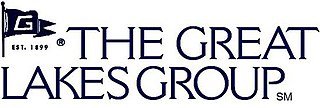
The Great Lakes Group (GLG) is an American full-service marine-related transportation company headquartered in Cleveland, Ohio. The Great Lakes Group is the parent Company to The Great Lakes Towing Company, Great Lakes Shipyard, Tugz International L.L.C., Puerto Rico Towing & Barge Co., Soo Linehandling Services, Admiral Towing and Barge Company, and Wind Logistics, Inc.

Marine Transportation Services (MTS) formerly Northern Transportation Company Limited (NTCL) is a marine transportation company operating primarily in the Mackenzie River watershed of the Northwest Territories and northern Alberta, and the Arctic Ocean using a fleet of diesel tug boats and shallow-draft barges. NTCL filed for bankruptcy in 2016 and its assets were acquired by the Government of the Northwest Territories later that year.
Waterways is a locality within the Regional Municipality of Wood Buffalo in northern Alberta, Canada. It is now a neighbourhood within the Fort McMurray urban service area along the west bank of the Clearwater River, south of the river's confluence with the Athabasca River.

The Radium Queen and her sister ship the Radium King were built in Sorel, Quebec in 1937, for the Northern Transportation Company, a subsidiary of Eldorado Gold Mines. The Radium Queen was a cargo/tug ship that served on the Slave River. It made runs between Lake Athabaska and Great Slave Lake which is generally navigable. The Radium Queen towed barges from the railhead at Waterways, Alberta to a portage around the rapids. Cargo was unloaded there and transported by land, and loaded on barges on the lower river that were towed by the Radium King, and later by other tugboats, like the Radium Charles, Radium Express and Radium Yellowknife.
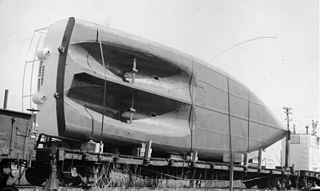
The Radium Express is a Russel Brothers tugboat operated by the Northern Transportation Company. The vessel was built in Owen Sound, Ontario, disassembled, and then shipped by rail to Waterways, Alberta, which was then the terminus of the North American railway grid.
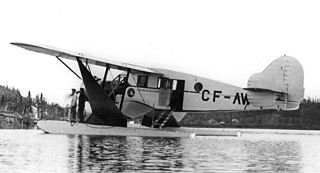
The Eldorado Radium Silver Express was the name of a semi-regular air service between Edmonton, Alberta and Port Radium, Northwest Territories, or between Port Radium and a refinery at Port Hope, Ontario. A single airplane, a Bellanca Aircruiser, a small bush plane, provided this service, from 1935 to 1947.

Algorail was a lake freighter owned and operated by Algoma Central. The ship was built by Collingwood Shipyards in Collingwood, Ontario and was launched in 1967. The ship sailed on the North American Great Lakes and the Saint Lawrence Seaway delivering coal/coke, aggregates, slag, iron ore/oxides, salt, fertilizers, grain products, gypsum, quartzite, or sand. The ship was laid up in 2016 and sold for scrap in 2018.
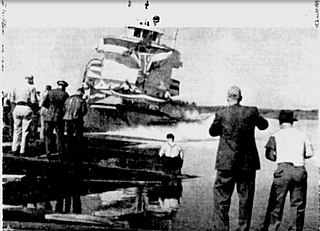
The Radium Yellowknife is a Canadian tugboat. Like other vessels built for service on the MacKenzie River, its tributaries, and Great Bear Lake and Great Slave Lake, she was first built in a shipyard in Vancouver, British Columbia, then disassembled and shipped by rail to Waterways, Alberta. There she was reassembled and launched into Clearwater River on August 18, 1948 - late in the season, as the rivers used to freeze in late September or early October. Her reassembly was delayed initially by floods in the Fraser valley in May hindering transport, and then by a derailment of several of the railway cars carrying her components. After launch, she sailed to the portage on the Slave River at Fort Smith, Northwest Territories and was dragged overland across the portage to the lower river, where she could then access the Great Slave Lake, the MacKenzie River, and the Beaufort Sea.

The SS St. Marys Challenger is a freight-carrying vessel operating on the North American Great Lakes built in 1906. Originally an ore boat, she spent most of her career as a cement carrier when much larger ore boats became common. After a 107-year-long working career as a self-propelled boat, she was converted into a barge and paired with the tug Prentiss Brown as an articulated tug-barge. Before conversion, she was the oldest operating self-propelled lake freighter on the Great Lakes, as well as being one of the last freight-carrying vessels on the Great Lakes to be powered by steam engines.

The Radium Cruiser was a Russel Brothers tugboat operated on the Mackenzie River system for the "Radium Line". She was constructed in Owen Sound, Ontario, in 1939, then disassembled and shipped by rail to Waterways, Alberta. Waterways is a river port, and was then the northern terminus of the North American railway grid. Waterways is on the Clearwater River, not far upstream from where the river empties into Lake Athabasca. The waters of Lake Athabasca flow into Great Slave Lake down the Slave River, and then down the Mackenzie River to the Arctic Ocean.

The Radium Gilbert was a tugboat built for transporting supplies to, and ore from, the radium and uranium mines in Canada's Northwest Territories. Like the other tugs in the Radium Line she was steel-hulled.
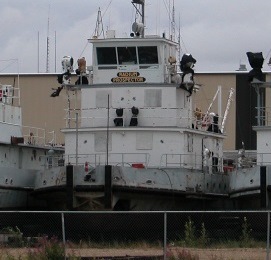
The Radium Prospector was a tugboat operated by the Northern Transportation Company's "Radium Line", on the tributaries of the Mackenzie River in Canada. She was launched in 1956. Many of her sister ships also included "Radium" in their name, hence the appellation "Radium line".
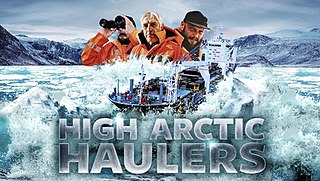
High Arctic Haulers is a television series that follows the annual sealift by Groupe Desgagnés that supplies the isolated communities in Canada's Arctic Archipelago. The first episode of the seven episode first season was broadcast on the CBC on January 5, 2020. The series was produced by Great Pacific Media.

The Lister was a tugboat built for the Northern Transportation Company (NTCL), in 1970. She operated out of the intermodal terminal at Hay River, NWT.

Ore Steamship Company and the Ore Navigation Corpoartion were subsidiaries of the Bethlehem Steel Company founded in New York City in 1927. Ore Steamship Company was a proprietary company that was founded so Bethlehem Steel could move goods needed by Bethlehem Steel Company. Ore Steamship Company would transport iron ore to the Bethlehem Steel mills on the Atlantic coast. Some ships took steel and steel products to Bethlehem Shipyards. Port of Baltimore was a major Bethlehem Steel port, the dock was 2,200 feet long in order to load and unload three large, 28,000-ton cargo ships at the same time.















